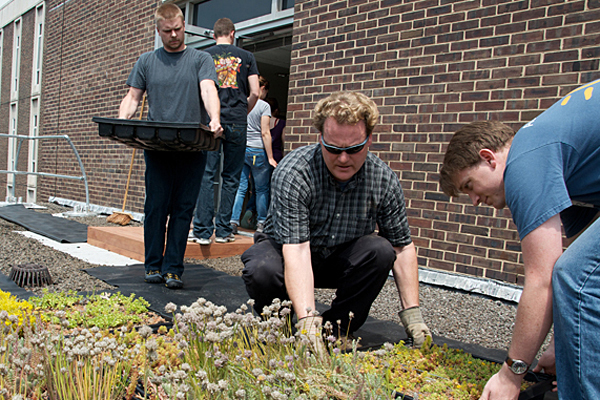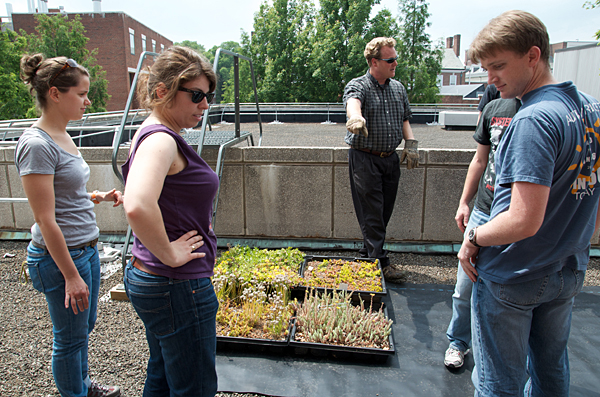Roof goes green
University's first green roof takes root at Colburn Laboratory
8:41 a.m., June 6, 2011--The University of Delaware’s first green roof, partially installed on Colburn Laboratory two weeks ago, came about because Annette Shine and her students were too hot to concentrate.
Shine, an associate professor of chemical engineering, used to teach in Room 102, in an older section of Colburn with an HVAC system that’s switched between heat and air conditioning twice a year. Invariably, there were unseasonably warm days in fall and early spring when Shine and her students sweltered.
Campus Stories
From graduates, faculty
Doctoral hooding
It made it hard to focus on chemical engineering problems on the blackboard but one day it got Shine and her teaching assistant, Kathy Phillips, thinking about a different kind of engineering problem – would it be possible to put a green roof over their heads?
Shine knew that a green roof could be installed at a fraction of the cost of replacing the annex’s old-school HVAC system. She did some research and discovered that a green roof planted to a depth of four inches could lower the temperature in her classroom by six degrees or more, which could mean the difference between comfortable and attentive students or hot and distracted ones.
The environmental benefits of a green roof are significant. A 4,000-square-foot green roof reduces carbon dioxide emissions by more than one metric ton per year, primarily as a result of reduced summer air-conditioning demand.
“Our green roof will act as a ‘sponge’ to reduce storm water runoff by about 9,000 cubic feet per year,” says Shine. “This will improve water quality in the White Clay Creek and the Delaware River. But I believe one of the most important benefits will be that the 600 engineering students using Colburn 102 will see and feel first hand that 'green' solutions are viable options for solving engineering problems.”
The duo’s first step in putting a green roof over their heads was to connect with Tom Sims, deputy dean of UD’s College of Agriculture and Natural Resources, for assistance.
As it turns out, Chad Nelson, an assistant professor of landscape design, and student Aaron Hallett were trying to start a green roof project, too. The four teamed up and other students and staff soon joined in.
Considerable engineering and horticultural know-how go into creating a green roof. Typically, outside experts handle it all, but the UD team was able to execute much of the design and installation themselves.
The most important order of business was a structural engineering study, which was funded by the UD Energy Institute. Each 2-foot by 2-foot module of plants now growing on Colburn’s roof weighs 50 to 80 pounds after a rainstorm. Once the project is complete, there will be 900 modules, providing more than 3,600 square feet of greenery. That’s a lot of weight on one roof, but the study indicated that the existing roof could safely handle it.
Shine and Nelson visited several other green roofs, as close as Sanford School in Hockessin and as far as Chicago. “One of the first things we did was talk to Ed Snodgrass, a Maryland nurseryman who is considered the father of the green roof movement in the U.S.,” says Nelson.
The visits got the creative juices flowing and Nelson and his students started to play with design ideas. “We thought about a pattern with UD blue and yellow but we couldn’t find blue-colored plants that were tough enough to withstand conditions on a roof,” says Nelson. The annex’s roof is visible from the second floor of a newer section of Colburn so it was important to design for four-season appeal.
Debating between six-sided sedum, chive and Tommy crocus is the fun part. But, first, additional money had to be raised, which isn’t nearly as much fun. UD’s Sustainability Fund, the Delaware Department of Natural Resources and Environmental Control's Greenhouse Gas Reduction program and DuPont’s Clear into the Future program all kicked in funds.
About 20 students helped to install 220 square feet of modules during the first phase of installation, two weeks ago. Tough, shallow-rooted sedums are the backbone of most roof gardens and Colburn is no exception. One module contains six-sided sedum interspersed with dragon’s blood sedum, which has brilliant red flowers in late summer and green foliage that will turn orange-red in fall.
The plants were propagated at UD’s Fischer Greenhouse and other locations by UD students, Girl Scouts, Master Gardeners and members of the Friends of the University of Delaware Botanic Gardens.
Plants are currently being propagated for phase two -- half of which will be installed in October, the other half in spring 2012. Every Friday, a work session is held at the greenhouse from 3 p.m. to 5 p.m. Volunteers help propagate plants and can learn more about green roofs. To participate, email Nelson at cnel@udel.edu.
Article by Margo McDonough
Photos by Danielle Quigley












